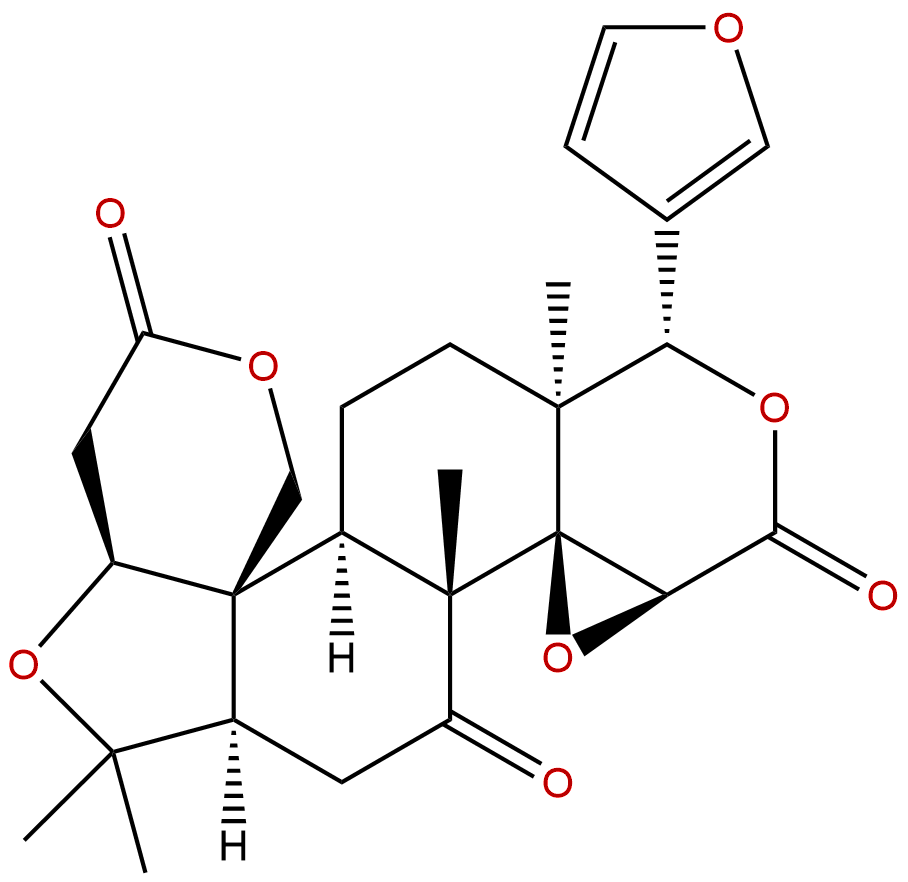
LimoninCAS No.:1180-71-8 |
||||||||||
 |
|
|
||||||||

| Catalogue No.: | BP0866 |
| Formula: | C26H30O8 |
| Mol Weight: | 470.518 |
| Botanical Source: | Aurantii fructus immaturus |
Synonym name: Limone; Citrolimonin; Evodine; Dictamnolactone; Obaculactone
Catalogue No.: BP0866
Cas No.: 1180-71-8
Formula: C26H30O8
Mol Weight: 470.518
Botanical Source: oranges and other citrus fruits (Citrus spp.). Also from other Rutaceae spp., e.g. Evodia, Phellodendron, Dictamnus and Luvunga spp.
Purity: 95%~99%
Analysis Method: HPLC-DAD or/and HPLC-ELSD
Identification Method: Mass, NMR
Packing: Brown vial or HDPE plastic bottle
Can be supplied from milligrams to grams.
For Reference Standard and R&D, Not for Human Use Directly.
Inquire for bulk scale.
Description:
Limonin is a widely used dietary supplement, one of the most prevalent citrus limonoids, which has antioxidant, anti-inflammatory, anticancer and anti-human immunodeficiency virus(HIV)activity. It induced a down regulation of TLR-2 ,TLR-4,TNF-α, TNF-α/IL-10,NF-κB and caspase. It showed the potent inhibition of CYP3A4, with IC50 values of 6.20 μM (CYP3A4/testosterone) and 19.10 μM (CYP3A4/midazolam).
References:
J Nat Sci Biol Med. 2013 Jan;4(1):126-33.
Influence of limonin on Wnt signalling molecule in HepG2 cell lines.
The role of Limonin as potent anti carcinogenic, apoptosis and chemotherapeutic agents has been supported by limited studies.
METHODS AND RESULTS:
In this study, Limonin is identified as a potent anti proliferative agent against human hepatoma HepG2 cells based on the cell viability study, LDH leakage assay. Induction of apoptosis in HepG2 cells by Limonin was evidenced by western blot analysis of Bax, Cyclin D1, Caspase 3 and Caspase9. Since Wnt signalling is involved in the initiation and sustaining of hepatocellular carcinoma we studied differential expression of LRP5, LRP6 and DKK wnt players.
CONCLUSIONS:
Limonin found to down regulate these players which forms a rationale for further investigation on effect on Limonin in cancer therapy.
Planta Med. 2003 Oct;69(10):910-3.
Effect of limonin and nomilin on HIV-1 replication on infected human mononuclear cells.
In the last years several plant-derived natural compounds have been screened for their anti-HIV activity in order to find lead compounds with novel structures or mechanisms of action. Among these, several triterpenoids have been found to exhibit an antiretroviral activity with different mechanisms of action.
METHODS AND RESULTS:
In this study the effect of two limonoids, Limonin and nomilin, on the growth of human immunodeficiency virus-1 (HIV-1) in culture of human peripheral blood mononuclear cells (PBMC) and on monocytes/macrophages (M/M) is described. Limonin and nomilin were found to inhibit the HIV-1 replication in all cellular systems used. A dose-dependent inhibition of viral replication was observed in PBMC isolated from healthy donors and infected with HIV-1 strain after incubation with Limonin and nomilin (EC (50) values: 60.0 microM and 52.2 microM, respectively). The two terpenoids inhibited at all concentrations studied the production of HIV-p24 antigen even when the PBMC employed were chronically infected (EC (50) values of 61.0 microM for Limonin and 76.2 microM for nomilin). Moreover, these compounds inhibited the HIV-1 replication even in infected M/M. In this cellular system the inhibitory effect was significant at the concentrations of 20 microM, 40 microM and 80 microM starting from day 14 and reached the maximum effect after 18 days of incubation. As regards the mechanism of action, Limonin and nomilin inhibit in vitro HIV-1 protease activity.
CONCLUSIONS:
In general, the results obtained point out a similar anti-HIV activity of Limonin and nomilin indicating that this activity is not drastically influenced by the structural difference between the two compounds.
Eur J Pharmacol. 2014 Oct 5;740:676-82.
Limonin attenuates hepatocellular injury following liver ischemia and reperfusion in rats via toll-like receptor dependent pathway.
Limonin has been shown to exhibit anti-inflammatory and antioxidant properties in the settings of chemically induced hepatic injury.
METHODS AND RESULTS:
The current study aimed to investigate the protective effects of Limonin on experimentally-induced hepatic ischemia reperfusion (I/R) injury in rats. Rats were injected IP with either DMSO or Limonin (100 mg/kg BW), 30 min before submission to 45 min of ischemia, followed by 1 h of reperfusion. Limonin ameliorated the deleterious effects of I/R as indicated by improvement in liver function tests, reduction of lactate dehydrogenase, reduction of oxidative stress, decrease in hepatocyte degeneration, and pyknosis. Furthermore, pretreatment of I/R rats with Limonin, induced a significant down regulation in the various elements of the toll like receptor (TLR)pathway including TLR-2 and TLR-4, myeloid differentiation factor 88 (MYD88) and toll/IR-1(TIR)-domain-containing adaptor protein inducing interferon-beta (TRIF) and the downstream effectors TNF-α, TNF-α/IL-10 ratio and nuclear factor-κB (NF-κB). It also increased the anti-inflammatory cytokine IL-10 and decreased the activity of the apoptotic marker, caspase-3.
CONCLUSIONS:
These data indicate that Limonin exerts antioxidant and anti-inflammatory effects in ischemic liver, thus, protecting hepatocytes against I/R injury in rats. The mechanism of these hepatoprotective effects appears to be related to the antioxidant and anti-inflammatory potential of Limonin mediated by the down regulation of TLR- signaling pathway.